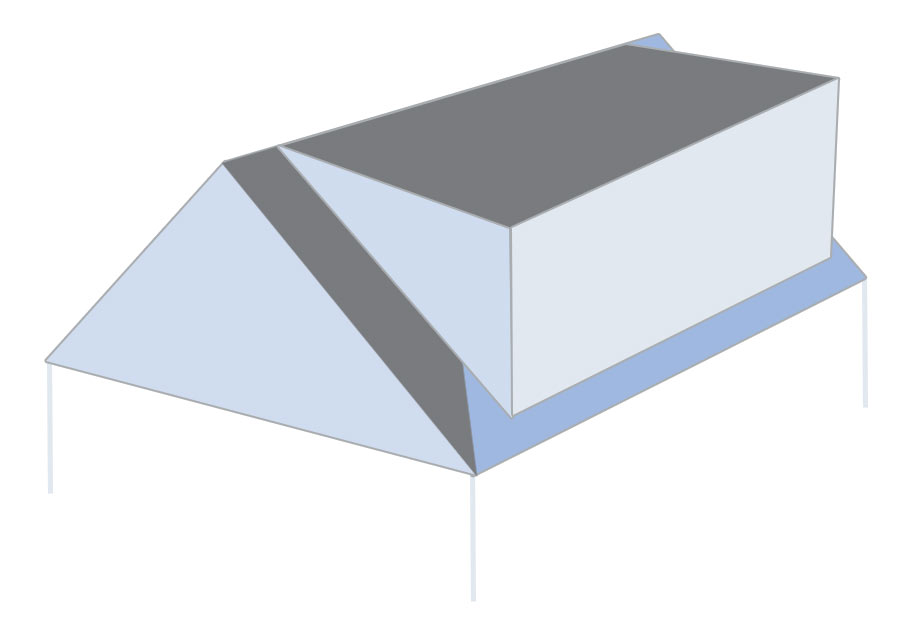There’s no doubt that a loft conversion offers a great way to add value to your home but to ensure you get the most from your investment, it’s important to choose the best type of conversion for your home.
There are five main types of loft conversion: roof light/Velux conversions, dormer conversions, hip-to-gable conversions, mansard conversions and L-shaped. The best type for your home will depend on the shape and height of your roof, whether your home is detached, semi-detached or terraced, your budget, and any local planning restrictions or requirements.
Roof light loft conversion
Adding roof lights is the cheapest way to convert a loft, providing your existing roof space is big enough and you have sufficient head height. Roof light conversions cost less than other types of loft conversion because there’s no need to make any changes to the pitch or shape of the roof. All that’s required to create valuable extra living space is the addition of skylight windows, a proper floor and a staircase. As a roof light conversion doesn’t require as much work as other types of extension, this type of project is usually takes around a month from start to finish, depending on whether you’d like additional work such as an en-suite bathroom.
Pros:
- planning permission isn’t required in most cases
- roof light loft conversions are the cheapest option
- minimal disruption/construction work required
- get the extra space you need at a fraction of the cost of moving house
Cons:
- the finished space might be less versatile compared to a full conversion, depending on the height of your roof
- this type of conversion might not allow for value-boosting ‘extras’ such as an en-suite bathroom


Dormer loft conversion
A dormer loft conversion offers a great way to provide even more space as although they’re marginally more expensive than a simple roof light conversion, a generous amount of extra floor space and headroom can be added.
Pros:
- planning permission isn’t required in most cases
- a dormer provides maximum headroom, helping to create a versatile space with lots of room
- dormer windows or French doors coupled with a glass balcony allow natural light to flood the space
- a great investment which will add value to your home whilst enhancing your lifestyle
- there’s a dormer out there to suit all types of home: from Georgian and Victorian, through to pre-war and contemporary
Cons:
- flat roof dormers are perfect for providing lots of extra space, however they sometimes don’t have the same aesthetic appeal of other types of loft conversions
Hip to gable loft conversion
Hip-to-gable loft conversions are only suitable for properties with a free sloping side roof. This type of conversion creates plenty of space by extending the sloping ‘hip’ at the side of a house outwards and upwards to create a ‘gable’ side wall. Hip-to-gable loft conversions usually get built with a rear dormer to maximise available space.
Pros:
- a fantastic way to create lots of space which is ideal for anything from an extra bedroom and bathroom, through to a home office or even a gym!
- ideal for detached, semi-detached homes or bungalows
- better value than an external extension and cheaper than moving house
- add value to your home
Cons:
- if you’ve already added other permitted development extensions to your home (e.g. a conservatory or rear extension), we might need to assist you with planning permission
- if roof space is limited, it might be necessary to consider other options


L-shaped loft conversions
This type of loft conversion offers the potential to create a significant amount of additional space and is a great way to provide lots of additional headroom. In addition, L-shaped loft conversions offer plenty of configuration options such as multiple rooms. L-shaped loft conversion involve the creation of two dormers which connect into a dormer. One end of the dormer is built into the main roof whilst the other end of the dormer is built into the roof an an existing rear extension.
Pros:
- a great way to create lots of space with multiple rooms.
- L-shaped loft conversions can be used to provide additional headroom.
Cons:
- only suitable for properties which already have an existing rear extension
Mansard loft conversion
Mansard conversions alter the entire shape of a roof, making the roof structure almost vertical. Although this type of conversion is the most expensive because of the amount of work required, they offer a great way to add a significant amount of extra space. This type of loft conversion is suitable for most types of property and is widely seen in terraced homes throughout London. The side walls of mansard loft conversions are usually constructed of bricks to blend into the existing walls of the property with the rear façade usually finished with slates or tiles. Some London borough planning departments prefer this style of loft conversion as they may be more in-keeping with the original properties in the area.
Pros:
- create a huge, versatile space, flooded with natural light
- add value to your home
- get the space you need without having to move house
- suitable for the majority of homes
Cons:
- planning permission is often required for this type of loft conversion
- the services of a structural engineer may be required to check that the existing structure can cope with the extra strain – we can arrange this for you

How do I start my loft conversion?
The best way to start is by contacting us! We’re happy to provide advice and guidance on the most suitable type of loft conversion for your home. To find out more, or to obtain your free, no-obligation quote, get in touch with Berry Construction by calling 0208 945 7900 or email info@berryconstructionuk.com



